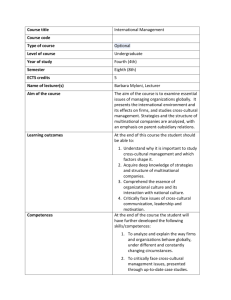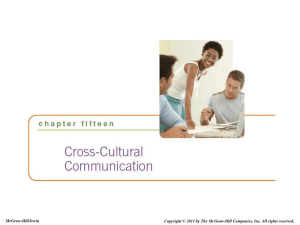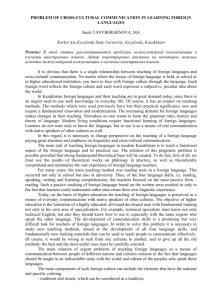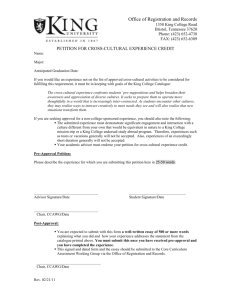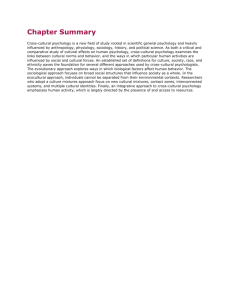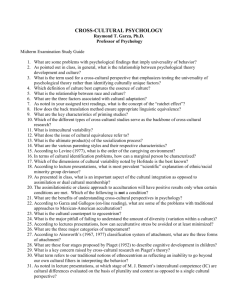Communicating Across Cultures
advertisement
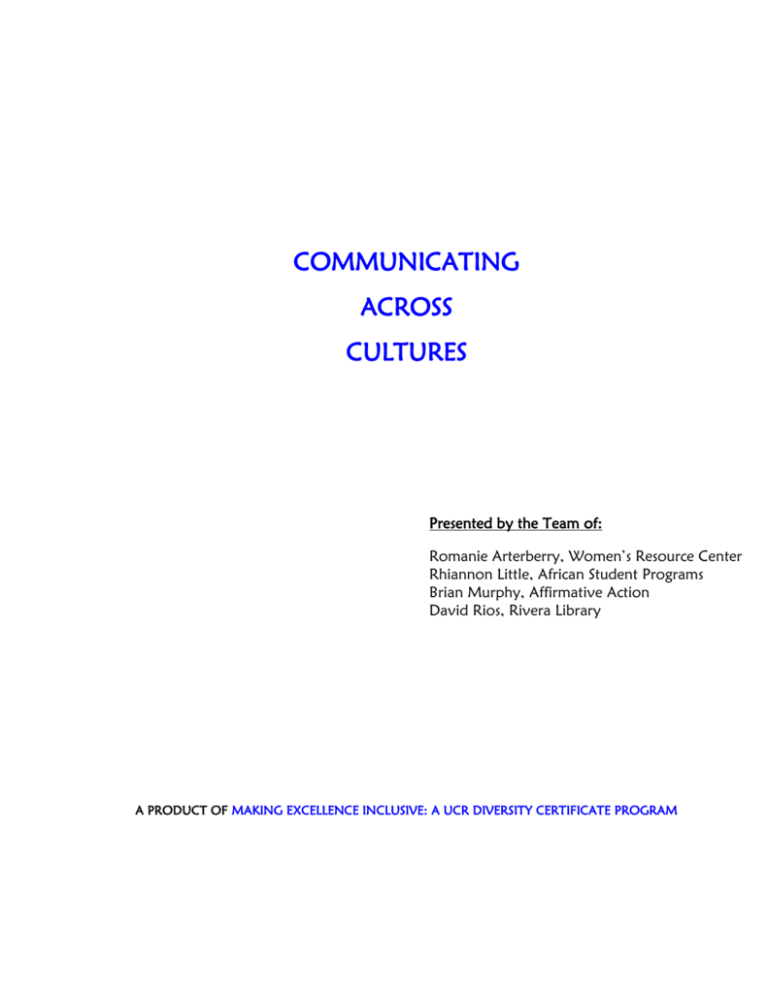
COMMUNICATING ACROSS CULTURES Presented by the Team of: Romanie Arterberry, Women’s Resource Center Rhiannon Little, African Student Programs Brian Murphy, Affirmative Action David Rios, Rivera Library A PRODUCT OF MAKING EXCELLENCE INCLUSIVE: A UCR DIVERSITY CERTIFICATE PROGRAM Executive Summary “Cross-cultural communications” can mean anything from grasping the significant differences in both spoken and unspoken exchanges in drastically remote geographical or social communities, to more subtle contrasts in perspective that exist even between neighbors. The key in any form of communication is to know your audience; know to whom you are speaking, and by doing so, to communicate in common terms. But that is only half the lesson. Because communication requires both a ‘transmitter’ and a ‘receiver’ it is as much the duty of the listener to interpret to the benefit of the speaker as it is the speaker to be sensitive to the listener. No one is served if we choose to be offended or close communications without giving the communicator a chance to clarify. Introduction Living and working in a diverse community is more than bringing together a polyglot collection of faces under a single employment roof. Succeeding in a diverse community requires the ability to work together in an atmosphere of understanding and cooperation that establishes a productive, safe and efficient workplace. Recruiting a team that represents a healthy cross-section of lifestyles and experiences is only the beginning. The ability to communicate in a comfortable and effective manner is the foundation for a high-production, low-risk work environment. Problem Definition Nothing is more basic to maximize efficiency and productivity than effective communications between co-workers. In today’s market where the workplace has become a melting pot of the entire spectrum of demographic cultures, communication skills have an elevated significance. Unfortunately, only a very small segment of the workforce is specifically trained for this, or even aware of the necessity. As a result, simple misunderstandings can escalate into larger problems. The risks range from reduced productivity to monumental legal costs, yet both the public and private sectors have been slow to commit time and resources to prevent avoidable, but potentially devastating risk. Best Practices Raising awareness by establishing training programs and providing cross-cultural exchange opportunities is a no-risk, high reward investment any employer can make in their human capital. Based on the benefits to students in a diverse academic atmosphere as documented by Dr. Mitchell Chang, Jeff Milem, et alia, this is especially true in higher education. Additionally, creating resources where employees can turn to learn for themselves and, as an employer, encouraging employees, even offering incentives, to take advantage of those resources is another “low-hanging fruit” option available to foster cross-cultural communications capabilities. For the individual, taking the time to educate oneself, and even more effectively, each other, can turn this liability into an immediate asset. The learning process itself is a bonding activity, a solid first step in the long journey that is multicultural competency – a skill as essential to the leaders of tomorrow as techno-savvy is today. For some easy tips, see Attachment A. Solution Details As diversity is rapidly becoming a component at all levels of training from new employee orientation, to supervisors and managers, to senior management, so should be both the importance and the mechanics of cross-cultural communications. The simplest and least expensive step any institution can take is to establish and promote a central web-based education site providing both information and links to additional information resources. This can be focused to reach both line-workers seeking to educate him/herself and, most particularly, supervisors looking for the skills to optimize their abilities managing a diverse workforce. Similarly, there are substantial on-line resources to assist faculty and students in cross-cultural communications to maximize the classroom experience as well. Key elements of a resource website include: A clear explanation of cross-cultural communications An explanation of the value of effective cross-cultural communications Examples of common cross-cultural miscommunications Links providing insight to other cultures, e.g., religious holidays, celebrations Links to other general diversity resources This resource is a natural outgrowth of the campus’s existing Diversity@UCR/ clearinghouse website and will be promoted as part of the overall DELI communications strategy. But resources alone will never replace education and training as a long-term solution for cross-cultural communications, diversity or any other paradigm-altering aspect of sociological evolution. Training components offer a continuity and sustainability that is the most effective, if not only proven, method to integrate change into the fabric of the institution and build the institution’s capacity for change. Interactive exercises that engage participants and allow everyone to both be themselves and step outside of themselves to view their predispositions from a new perspective. Key pieces to a cross-cultural communications component include: Scenarios actually demonstrating different communications issues Handouts with thought-provoking questions and quizzes challenging personal knowledge and preconceptions Risks The challenges are nothing new or exclusive. Resources, in terms of costs and time, are the obstacles. As budget crises force reductions in resources, and increases in duties demand more of employee time, convincing managers to commit to training becomes a greater problem. Even those cognizant and supportive of diversity training might need convincing that what is being offered is of value and not repetitive of other trainings. This is why we recommend the budget-friendly approach of on-line resources and sustainable training opportunities, with incentives for employees and supervisors to encourage participation. Benefits As indicated above, there are many potential benefits to “cross-cultural literacy” among employees. These include: Increased productivity An environment that employees have less tension/friction because they can make allowances for what and why others do things differently and in turn, co-workers grant the same allowance Improved employee retention Stronger in-house pool for succession planning/succession More attractive employment environment for recruiting Better academic support system (safer, more efficient) Measures Evaluation would be conducted through a feedback-reaction form on the website, or distributed as part of evaluation of any training in which the modules are used. Resources Mitchell Chang, Jeff Milem, et al LGBT Terminology http://out.ucr.edu NCBI Training Words that Exclude, UCR R.E.A.C.H. Program http://www.ehs.ucr.edu/training/diversity http://www.washington.edu/students/reg/0711religcal.html http://www.fcps.edu/DHR/employees/oec/relcal09.htm Kathleen Montgomery Susan Borrego Carlos Cortez ATTACHMENT A QUICK TIPS FOR CROSS-CULTURAL COMMUNICATIONS* Be aware of: Words, images and situations that suggest that all or most members of a demographic group are the same Possible negative implications of color symbolism and usage that could offend people or reinforce bias Objects, characters, gestures and symbols that could reflect different beliefs or values for different groups Varying standards in what different cultures consider humorous or taboo Different standards for loudness, speed of delivery, silence, attentiveness and time to respond to another's point Differences in body language interpretation, such as eye contact, proximity or physical contact Avoid: Using qualifiers that reinforce racial and ethnic stereotypes Racial identification except when it is essential to communication Language that has questionable racial or ethnic connotations Addressing individuals with terms such as “boys,” “girls,” “guys,” “gals,” “you people,” & “your people” Treating individuals as though they represent an entire demographic group Jumping to any conclusions without giving the speaker a chance to clarify Do: Use simple, common terms as much as possible, especially when you aware of cultural barriers Rephrase a statement if it appears the meaning might not have been clear, but be certain the listener knows you are making the same point and not another one Ask for clarification when a statement made to you makes you uncomfortable with its potential offensive implications * Adapted from a variety of web resources
